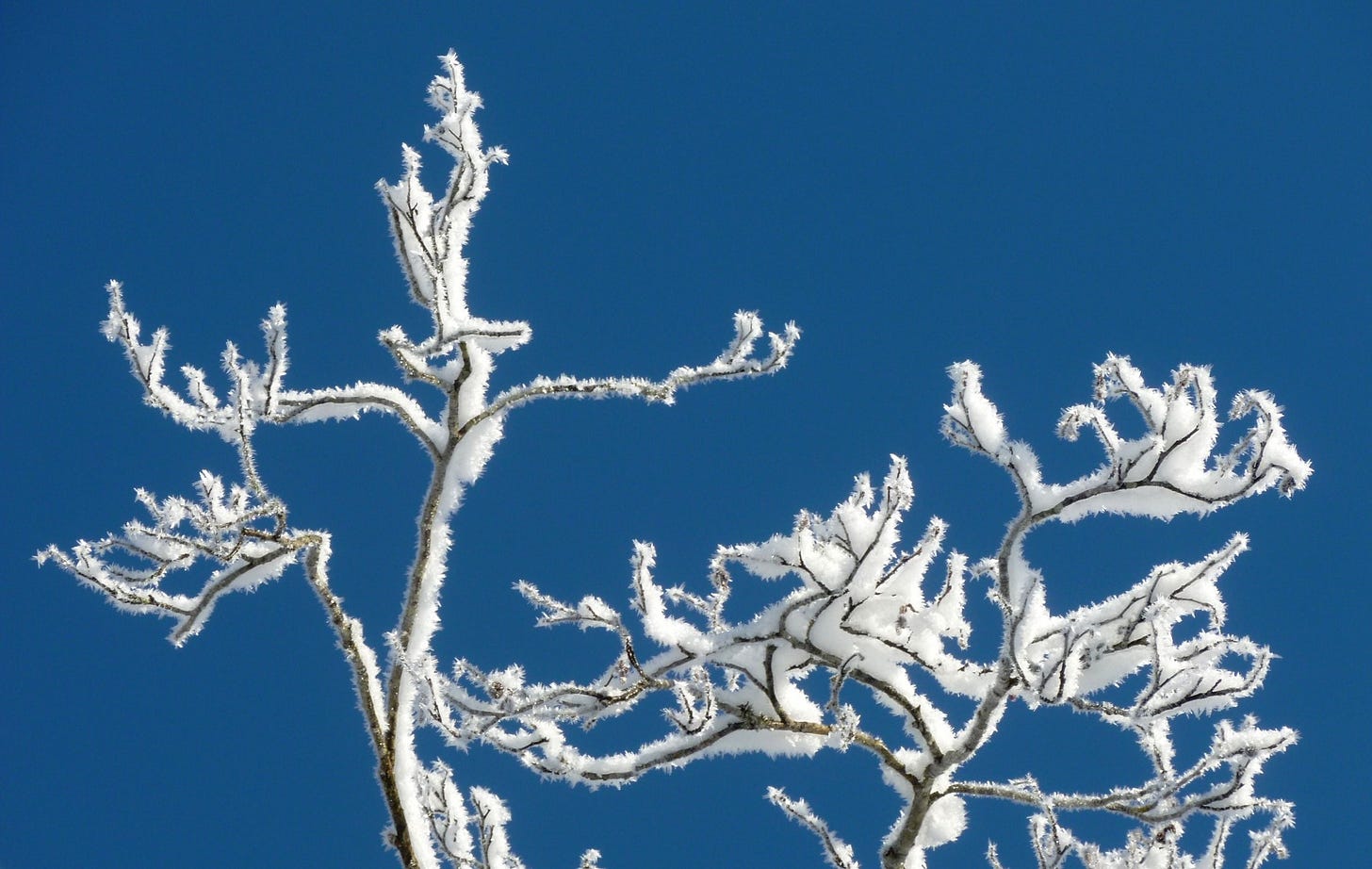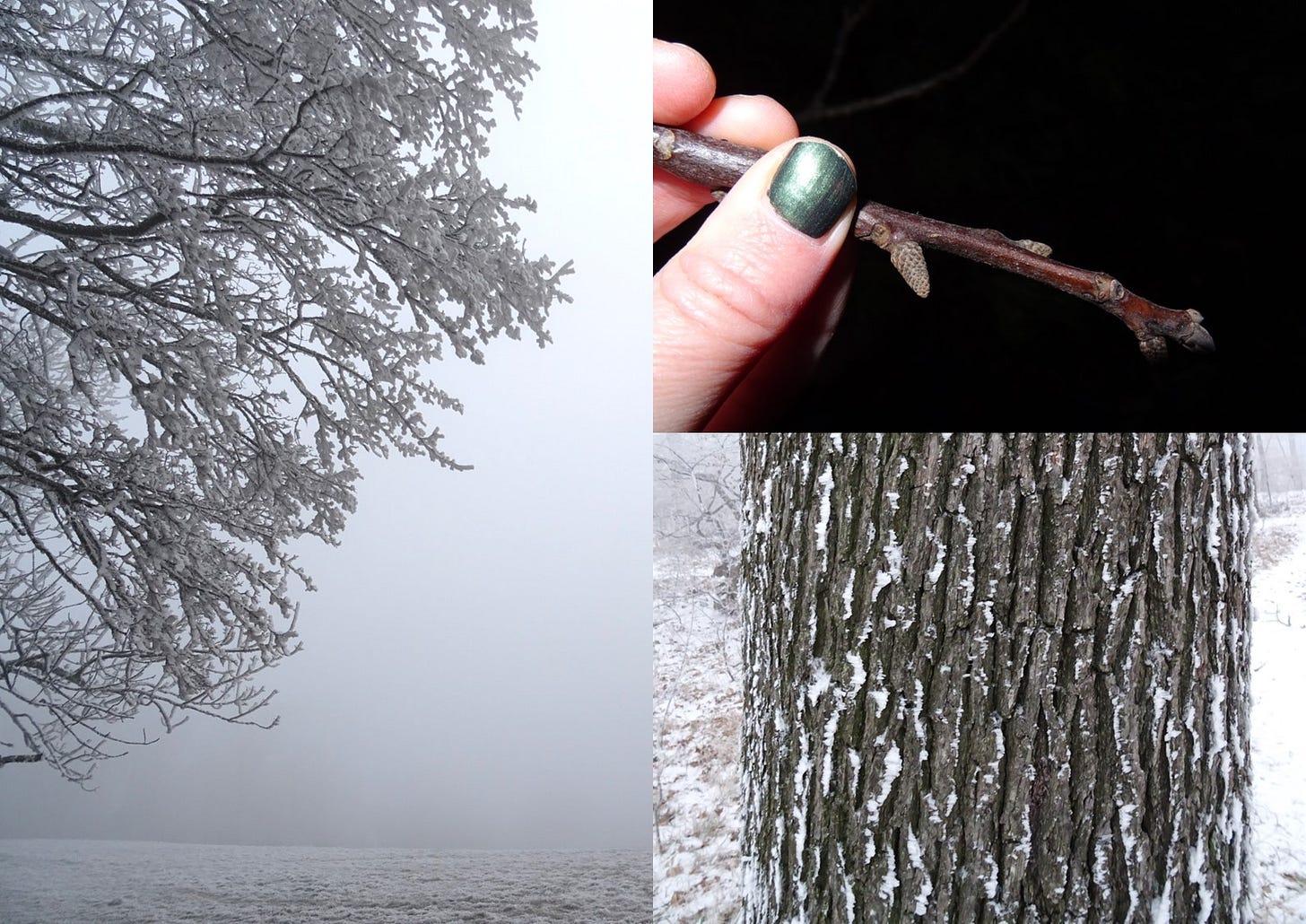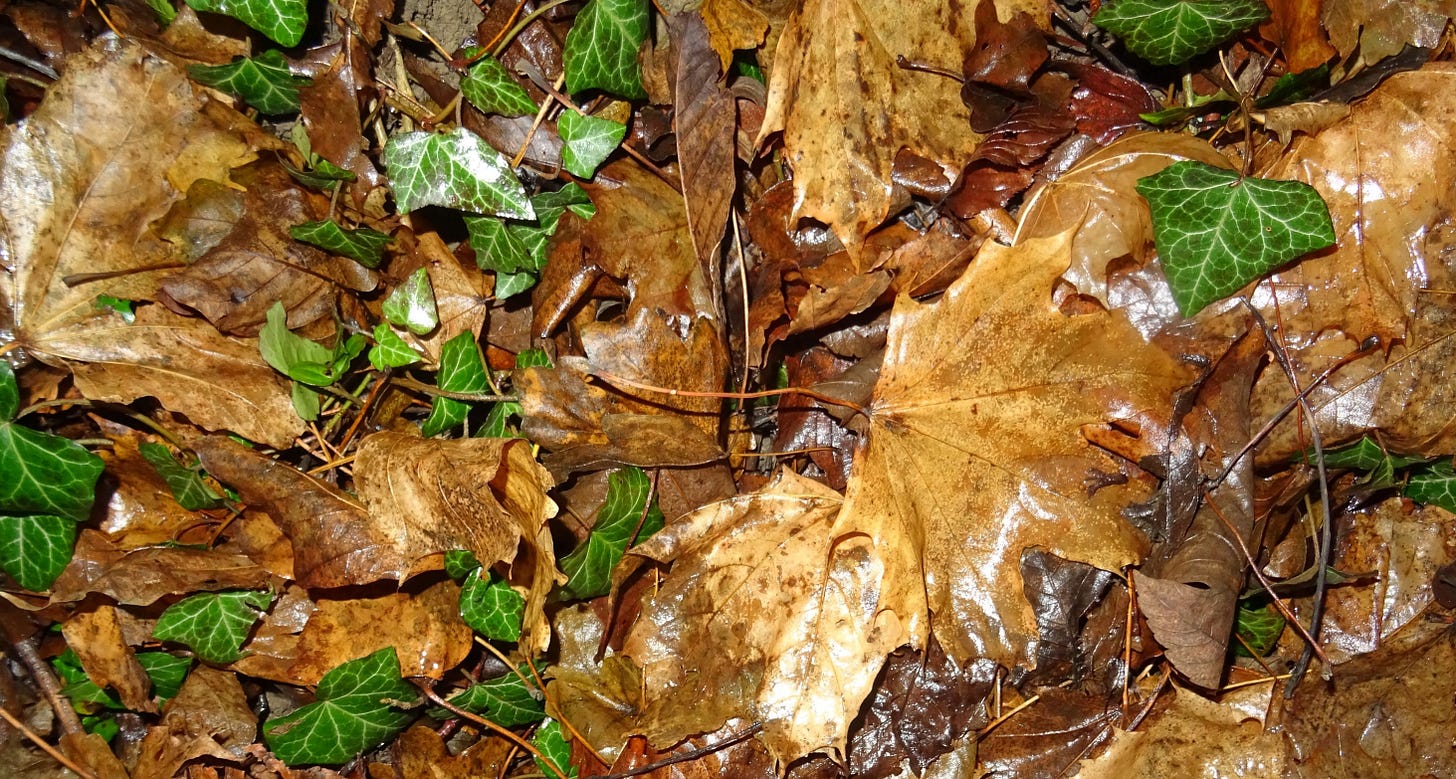Each month of 2025 will have a nature theme guiding my outdoor explorations and my reading. In January, the theme is Winter trees.
Starting the year with tree expeditions
Hi readers, and welcome to all new subscribers1! This month, I dive into tree species identification in winter (i.e. relying on the bark and buds rather than the leaves). I began the year with a fantastic hike through a foggy, snowy landscape – making getting up early on New Year’s Day and forcing my tired self into five layers of clothes worthwhile. It was completely quiet in the hills, the leaves were frozen and the branches decorated with ice formations. I knew that most trees in the area would be beeches or oaks, so on that day I focused on looking for and examining those – the only problem was that it was too cold to stop at any tree for long!
I’ve been on further “tree expeditions” in sunshine and rain, studying the bark and branches, but also the ground below the trees and the tree shape from the distance. I expected to enjoy this, but I am surprised by how much I do. Both the bark and the buds are so aesthetically pleasing! And it’s fascinating to see the variation between species – especially looking at the buds is opening a new little world to me.
Why identify species?
People who love nature are divided about whether we “should” identify species as part of our nature experience. It can seem like classifying and analysing nature instead of appreciating its wild messiness. I recently read Jane Goodall’s memoir “Reason for Hope”, where she writes
”Words can enhance experience, but they can also take so much away. We see an insect and at once we abstract certain characteristics and classify it - a fly. And in that very cognitive exercise, part of the wonder is gone. Once we have labeled the things around us we do not bother to look at them so carefully.”
I understand that perspective, but I see things differently. An initial “careful look” is often necessary to label an organism (as you’ll see for winter trees…) – and so, species identification provides a motivation to zoom in. As someone who generally tends to focus on the “big picture” (e.g. a whole landscape rather than individual plants), I find this deliberate switch to the details quite rewarding.
If you're curious about winter tree identification, read on for the four steps I’ve taken, as well as some tips and resources!
1. Getting some background knowledge
To learn key species and features of the trees, I watched educational YouTube videos. These are often filmed by tree enthusiasts just walking through the forest, highlighting details of the trees they encounter (I really enjoy that type of video – mushroom videos are great too!). I learned e.g. that species differ by the arrangement of the buds along the branches – directly opposite each other vs. alternating – and that some species have characteristic sticky buds. It's useful to choose videos focused on your region. Here are two examples for the UK and Norway.
2. Knowing what is around
It helps a lot to know which species to expect locally, so that you can start by learning the details of just a handful of common species. Maps or surveys of local tree species are often available online through nature organisations or official bodies. These can be fascinating if you love data (as I do) – but they can also be very detailed or require specialist knowledge. Alternatively, you can use iNaturalist (more details below) to see the most frequently observed species in your area2.
For learning, it is also useful to know some individual trees whose species you are sure of. Maybe a friend knows a lot about trees, or you remember individual trees you identified in summer (e.g. I am quite familiar with the lime tree next to my favourite bus stop…), or there is a nature trail with labelled trees nearby. But the best thing I found is that some cities / towns (sadly not mine!) have tree registries, where the species of many individual trees can be looked up on an interactive map (registries for London and Vienna).
3. Trying to identify species outdoors
With all my new knowledge, I have been attempting to identify trees out in the wild. What I do is simple: I walk into the woods and pick some random trees. I explore their bark and branches in detail, try to guess their species, and take photos I later use at home for the actual identification.
I expected to rely on the buds and bark only, but I was very wrong. It’s one of the things I’ve only noticed through this activity: The branches of many trees are not bare at all; they carry old leaves, fruit, or catkins informative for identification. And even if they don’t, the leaves on the ground might offer clues (well, unless there is a metre of snow!).
4. Final identification
At home, I use the photos to check my tentative outdoor identification and identify any trees I could not recognize at all (not a rare occurrence, I must say).
I use iNaturalist (my favourite website – highly recommended). You can upload photos of your tree (or any other organism), ideally showing different parts of it, and place it on a map. The software provides an initial AI identification; then community members (including experts) can confirm or correct it. It’s easy, and your observations contribute to a large dataset even used for research projects3.
I am usually a fan of books – so it may surprise you that I don't primarily use physical field guides. But I’ve often found them frustrating: they often list numerous species (including rare ones) without offering much guidance beyond “Just look at these 193 tree photos and find the correct one”. I occasionally flip through my book (I do own one) but don’t rely on it as a main tool.
Of course, I don’t follow these four steps strictly in order. It’s an organic process of becoming more familiar with the winter trees. I certainly already have a new perspective when I walk outdoors – I can't help but examine the buds of every tree I pass!
Do you enjoy looking at the trees around you? Have you tried species identification? If you have, please share your tips below! And if you haven’t, I hope this post was inspiring.
Enjoy the rest of the week – whether with or without trees!
Hannah
I hope you won’t immediately disappear again – I feel like this post is a bit nerdier than I planned!
Here is how it works on a PC (it might be different when using the app): Click Explore → Select your area on the map → Click “species” → Use “Filters” to show plants. The only disadvantage is that the result will show all plants, not just trees – so either you pick the trees manually, or you need to learn all the other plants too…
iNaturalist’s initial AI analysis often suggests several “candidate species” rather than a single answer. Especially in those cases, I check my book and look at more images online. This helps me decide which species is most likely and understand the small differences between the species.







The sheer sensory pleasure of being in nature is wonderful and does us a tonne of good, but what really nurtures our souls is building a deep connection with nature, an understanding that we are part of it, everything is interwoven and everything that affects nature ultimately affects us…. Getting to know the trees, just like this, and learning their names and their properties, histories and uses is a big part of that. Love your article Hannah!
I’m torn between just enjoying the sheer sensory pleasure of nature and wanting to name things. I used to run mindfulness walks on a nature reserve and often people would ask me what’s the name of that bird or tree and I would just ask them to just listen or just look and smell or feel the bark rather than trying to name everything or identify everything . But if people do want to identify trees in winter I discovered this for U.K. trees https://www.treeguideuk.co.uk/mini-guides/winter-tree-shape/